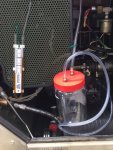I RTB. What have I missed? My average vacuum is 1" WG. In my case I used coffee, so it's actually CG.
3-5. CRANKCASE VACUUM,
3-5.1. General. The value depends to some extent on the type and size of air cleaner installed on the engine.
Regardless of type air cleaner used, vacuum with a clean air cleaner must not be less than a minimum of 0.79 in. (20
mm) water gage (WG). The vacuum is measured with a manometer at the lubricating oil dipstick hole with the engine
running. In engines in good condition vacuum increases slightly with engine speed but not proportionally. A fluctuating
vacuum may indicate faulty oil seals, valves, or piston blow-by troubles. Crankcase pressure can cause serious oil leaks
and often occurs in engines which need overhauling.
3-5.2. Measure Vacuum
a. Remove lubricating oil dipstick.
b. If water manometer is available, connect one end of a 0.374 in. (9.5 mm) OD plastic tube to a water manometer.
Insert other end of tube into dipstick hole, refer to FIGURE 3-1.
NOTE
Average vacuum should be 1.37 in. (34.8 mm) WG. Minimum allowed is 0.79 in. (20 mm) WG.
Warning
The noise level when operating could cause hearing damage. Ear protection must be worn.
3-14
ARMY TM 9-2815-252-24
AIR FORCE TO 38G1-92-2
c. Start engine and record reading on manometer.
d. Stop engine, disconnect manometer and install oil dipstick.
e. If water manometer is not available, place a piece of thick paper over the oil fill opening. If crankcase vacuum
retains paper, vacuum is good.

FIGURE 3-1. Locally Manufactured Water Manometer




